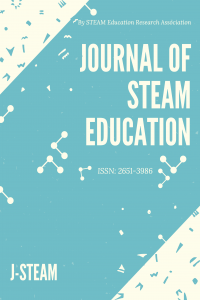Assessment of STEM Projects: Tacit Perspective of Turkish Science Education
Assessment of STEM Projects: Tacit Perspective of Turkish Science Education
With the worldwide spread of STEM education, which is considered as one of the most important developments of the 21st century in the field of education, the question of how to assess STEM education activities has emerged. In STEM education, where many interdisciplinary learning outcomes are applied together and where the learning process is more important, it is natural for the traditional summative assessment methods to lose their validity. In Turkey, the 2018 science course curriculum was updated with the components of STEM education and the importance of process assessment was emphasized, but there is no detailed explanation given on how to do it. However, formative assessment was discussed in detail in an earlier Turkish science curriculum. In this article, discussion is presented on how to use formative assessment in STEM education with the aid of 2005 Turkish science curriculum together with examples from various resources.
___
- Altunel, M. (2018). STEM education and Turkey: opportunities and risks [STEM eğitimi ve Türkiye: fırsatlar ve riskler]. Foundation for Political, Economic and Social Research (SETA), 207, 1-7.
- Haciomeroglu, G., & Bulut, A. S. (2016). Integrative stem teaching intention questionnaire: a validity and reliability study of the Turkish form. Journal of Theory and Practice in Education, 12(3), 654-669.
- Howes, A., Kaneva, D., Swanson, D., & Williams, J. (2013). Re-envisioning STEM education: Curriculum, assessment and integrated, interdisciplinary studies. A report for The Royal Society's Vision for Science and Mathematics Education. London, UK.
- Jolly, A. (2016, 14 Mart). Designing useful STEM classroom activities. Retrieved from https://www.edweek.org/tm/articles/2016/03/14/designing-useful-stem-classroom-assessments.html.
- Land, M. H. (2013). Full STEAM ahead: The benefits of integrating the arts into STEM. Procedia Computer Science, 20, 547-552.
- Lin, K. Y., & Williams, P. J. (2016). Taiwanese preservice teachers’ science, technology, engineering, and mathematics teaching intention. International Journal of Science and Mathematics Education, 14(6), 1021-1036.
- MacPhee, D., Farro, S., & Canetto, S. S. (2013). Academic self‐efficacy and performance of underrepresented STEM majors: Gender, ethnic, and social class patterns. Analyses of Social Issues and Public Policy, 13(1), 347-369.
- MNE (Ministry of National Education). (2005). Science and Technology Education Curriculum (Primary and Middle School 6., 7., 8th Grades). Ministry of National Education Press, Ankara, Turkey.
- MNE (Ministry of National Education). (2013). Science Education Curriculum (Primary and Middle School 3., 4., 5., 6., 7., 8th Grades). Ministry of National Education Press, Ankara, Turkey.
- MNE. (2016). STEM education report. Innovation and Educational Technologies General Directorate. Ankara. Retrieved from https://yegitek.meb.gov.tr/STEM_Egitimi_Raporu.pdf.
- MNE. (2017). STEM education teachers’ handbook. Innovation and Educational Technologies General Directorate. Ankara. Retrieved from http://scientix.meb.gov.tr/images/upload/Event_35/Gallery/STEM%20E%C4%9Fitimi%20%C3%96%C4%9Fretmen%20El%20Kitab%C4%B1.pdf.
- MNE (Ministry of National Education). (2018). Science Education Curriculum (primary and middle schools 3, 4, 5, 6, 7 & 8. grades). Ankara. Sarakorn, W., Santiboon, T., & Ponkham, K. (2017). Monitoring and evaluation students’ learning achievements through their learning activities with the STEM education instructional method for developing their creative thinking abilities and their attitudes toward science of secondary students at the 11th grade level in physics classes. European Journal of Education Studies 3(6), 455-481.
- Tyler-Wood, T., Knezek, G., & Christensen, R. (2010). Instruments for assessing interest in STEM content and careers. Journal of Technology and Teacher Education, 18(2), 345-368.
- Vanderstoep, S. W. & Johnston, D. D. (2009). Research methods for everyday life: Blending qualitative and quantitative approaches. CA: Jossey-Bass.
- Wiggins, S. (2015, 23 Temmuz). How to grade STEM projects. Retrieved from http://www.morethanaworksheet.com/2015/07/23/how-to-grade-stem-projects/.
- ISSN: 2651-3986
- Başlangıç: 2017
- Yayıncı: Şahin İDİN
Sayıdaki Diğer Makaleler
Mehmet Ali KÜPELİ, Sedef CANBAZOĞLU BİLİCİ, S.selcen GUZEY
Tusyanah TUSYANAH, Ismiyati ISMİYATİ, Edy SURYANTO, Nurdian SUSİLOWATİ
Assessment of Solid Waste Management at Source in Compliance With Guidelines
Learning With STEM Is Not Difficult At All!
Mustafa ÇEVİK, Özge ÇEVİK, Yunus BASAR, Büşra BİÇER
Assessment of STEM Projects: Tacit Perspective of Turkish Science Education
